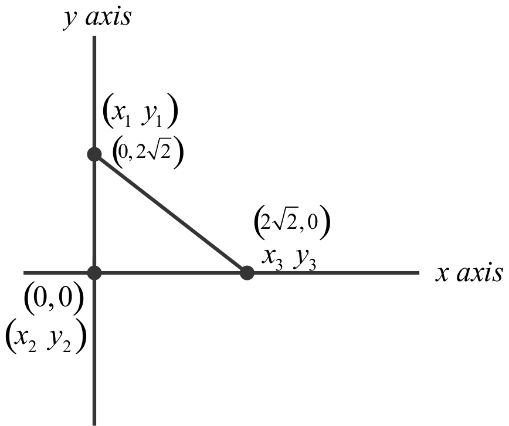Question
Question: Four identical particles each of mass \(1Kg\) are arranged at the corners of a square of side length...
Four identical particles each of mass 1Kg are arranged at the corners of a square of side length 22m. If one of the particles is removed the shift in the centre of mass is
(A) 38m
(B) 34m
(C) 32m
(D) 2m
Solution
Hint Four particles and their masses are given. It is given that the four particles are arranged in a square. The length of the side of the square is given. We have to find the shift in the centre of mass, if one of the particles is removed. To find that we have to find the position of centre of mass of the four particles and then position of centre of mass of the any three particles after that we have to find the shift in the centre of mass.
Complete step by step answer
Let us consider two particles joining a line, the position of centre of mass of line joining the two particles defined by x axis is given by
X=m1+m2m1x1+m2x2
X is the position of centre of mass
m1,m2 is the mass of the particles
x1,x2 is the distance of the particle from the origin
Let us consider n particles along a straight line taken in the x- axis, the position of the centre of the mass of the n system of particles is given by
X=m1+m2+.......+mnm1x1+m2x2+..........+mnxn
X is the position of centre of mass
m1,m2,mn is the mass of the particles
x1,x2,xn is the distance of the particle from the origin
Let us consider n number of particles, not lying on a straight line.
The position of centre of mass of the system of n particles is defined and located by the coordinates (X, Y) given by
X=m1+m2+.....+mnm1x1+m2x2+.......+mnxn
m1,m2,mn is the mass of the particles along x axis
x1,x2,xn is the distance of the particle from the origin in x axis
y=m1+m2+.....+mnm1y1+m2y2+.......+mnyn
m1,m2,mn is the mass of the particles along y axis
y1,y2,yn is the distance of the particle from the origin in y axis
Form a diagram with given information for better understanding of the question

FOUR IDENTICAL PARTICLES
From the diagram,
The points (x1,y1), (x2,y2), (x3,y3), (x4,y4) are (0,22), (0,0), (22,0), (22,22) respectively.
The mass of each particle is 1Kg
Given that the particles are arranged in a square, so the particles are not present in straight line
So, the position of centre of mass of the system of n particles which are not lying on the same line is given by
Along the x axis
⇒X=m1+m2+.....+mnm1x1+m2x2+.......+mnxn
Substitute the point values
⇒X=1+1+1+1(1×0)+(1×0)+(1×22)+(1×22)
⇒X=442
⇒X=2 →1
Along the y axis
y=m1+m2+.....+mnm1y1+m2y2+.......+mnyn
⇒y=1+1+1+1(1×22)+(1×0)+(1×0)+(1×22)
⇒y=442
⇒y=2 →2
From 1 and 2 the position of centre of mass of the four particles arranged in square C1 is
C1=(x1,y1)=(2,2)
Now, if we remove one of the particle, we get

THREE IDENTICAL PARTICLES
The points (x1,y1), (x2,y2), (x3,y3) are (0,22), (0,0), (22,0) respectively
The position of centre of mass of the system of n particles
Along the x axis
⇒X=m1+m2+.....+mnm1x1+m2x2+.......+mnxn
⇒X=1+1+1(1×0)+(1×0)+(1×22)
⇒X=322 →3
Along the y axis
⇒y=m1+m2+.....+mnm1y1+m2y2+.......+mnyn
⇒y=1+1+1(1×22)+(1×0)+(1×0)
⇒y=322 →4
From 3 and 4 the position of centre of mass of the four particles arranged in square C2 is
C2=(x2,y2)=(322,322)
The shift in the centre of mass is given by
shift=(x1−x22+(y1−y2)2
The points are C1=(x1,y1)=(2,2) and C2=(x2,y2)=(322,322)
⇒shift=(2−322)2+(2−322)2
⇒shift=(332−22)2+(332−22)2
⇒shift=(32)2+(32)2
⇒shift=92+92
⇒shift=94
⇒shift=32m
The shift in the centre of mass is 32m
Hence the correct answer is option (C) 32m
Note It is a simple question. If you know the right formulas to solve this question it will be very easy to solve. Since these points deal with the distance of the shift in centre of mass, its unit is metre.
